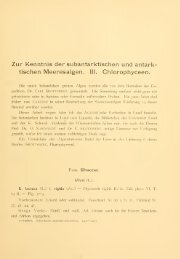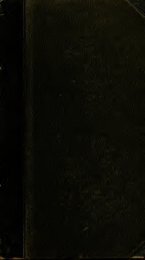Download PDF
Download PDF
Download PDF
You also want an ePaper? Increase the reach of your titles
YUMPU automatically turns print PDFs into web optimized ePapers that Google loves.
CHAPTER ELEVEN<br />
THE GENUS SIROCLADIUM RANDHAWA 1941<br />
This tentative genus is established on the basis of chromato-<br />
phores which resemble those of Mougeotia, and reproductive<br />
structures quite similar to those of Sirogonium. The vegetative<br />
cells are cylindric but variously curved, v^^ith plane end walls.<br />
The chromatophores are two broad parietal plates, each with<br />
several pyrenoids in a row, and the nucleus is supported by a<br />
cytoplasmic pillar between the flat sides of the chromatophores.<br />
The gametangia may become organized after an unequal division<br />
of a vegetative cell, or from a short undivided vegetative cell.<br />
Conjugation occurs between reflexed gametangia in adjacent fila-<br />
ments. Adhesion is followed by the growth of a pectic ring about<br />
the area of contact, but without the formation of tubes. The one<br />
known species is terrestrial and has rhizoids extending into the<br />
soil both as elongated basal cells and as outgrowths from other<br />
cells of a filament.<br />
Description of Species<br />
SiRocLADiuM KUMAOENSE Raudhawa 1941. Bot. Gaz. 103, p. 196.<br />
Vegetative cells cylindric, more or less irregularly bent, with plane<br />
end walls, 45-64 m x 120-210 /x; chromatophores 2; parietal plates 15-20 /x<br />
broad, each with 4 to 12 large pyrenoids arranged in a row. The nucleus<br />
is centrally supported by a cytoplasmic pillar between the 2 chromatophores.<br />
Conjugadon occurs between 2 geniculate gametangia without<br />
the formation of tubes. Receptive gametangia become inflated, zygo-<br />
spores are broadly ellipsoid, 42-70 /x x qo-io8/x; median spore wall yellow-brown<br />
and smooth. Parthenospores and aplanospores smaller and<br />
rounded, otherwise similar. (PI. XX, Figs. 11-14.)<br />
India, Upper Punjab, Almora, September and October, 1939. Found<br />
growing on moist clay on a ledge near a waterfall in the Kumaon Hills.<br />
Specimens of this remarkable plant have been examined by the author.<br />
The width of the chromatophores and the size of the pyrenoids are quite<br />
unlike any specimens of Sirogonium that I have seen. That it has certain<br />
features in common with this latter genus is unquestionable. In the specimens<br />
seen there was no evidence of spiral twisting of the chromatophores.<br />
It is possible that in the living material the chromatophores were even wider<br />
than the dimensions given above.<br />
119




